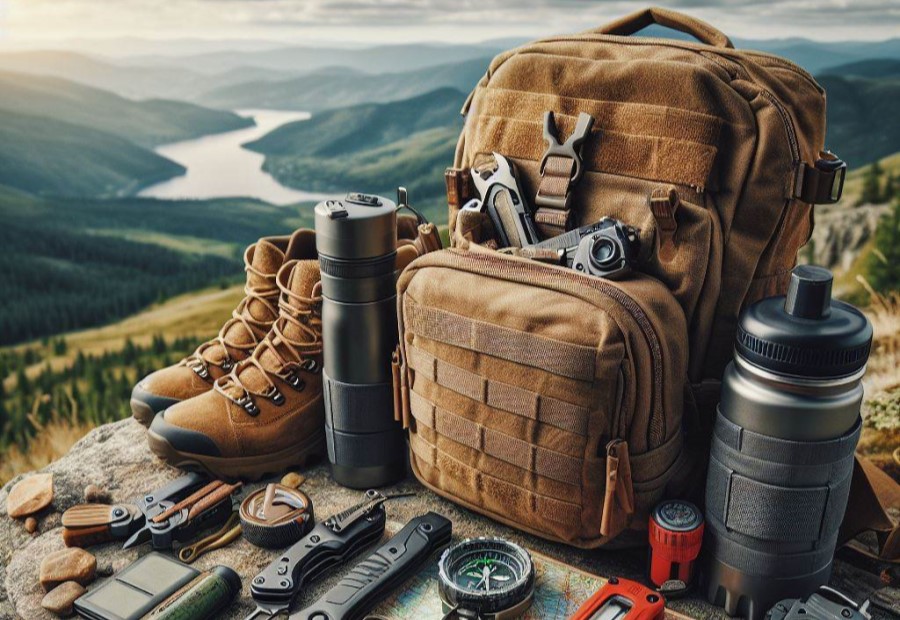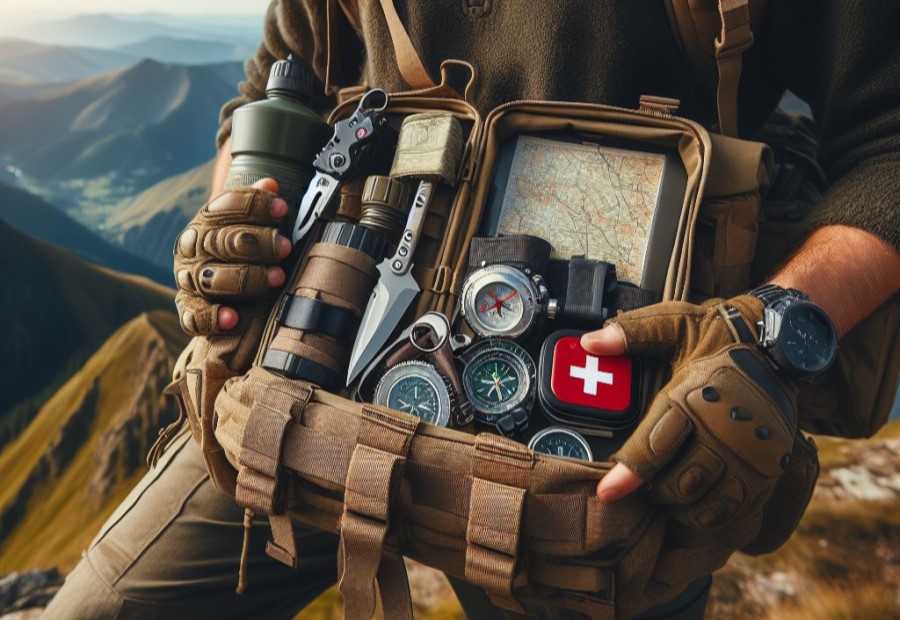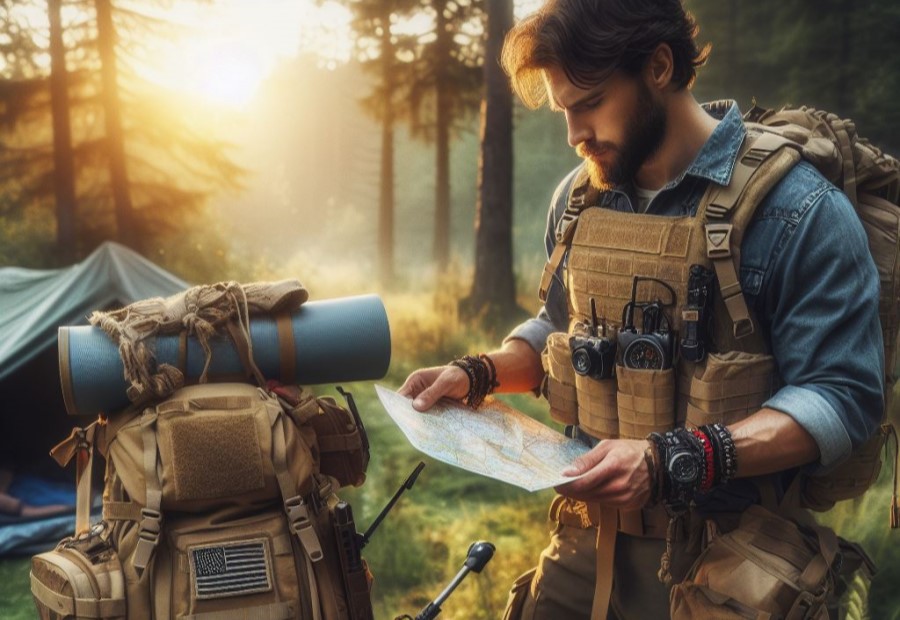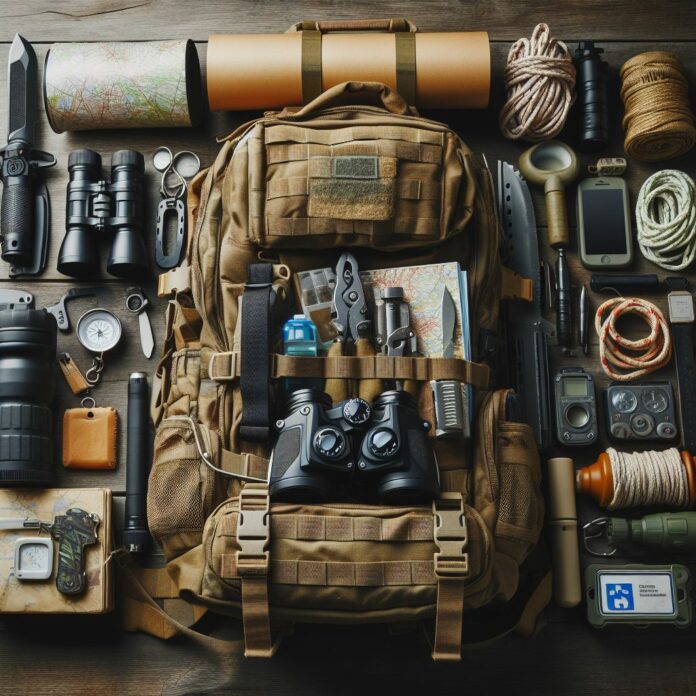Tactical hiking kits are essential for outdoor enthusiasts who enjoy hiking in challenging terrain or remote locations. A well-prepared tactical hiking kit can be a lifesaver in emergency situations or when facing unexpected obstacles.
This article will guide you through the key components to include in a tactical hiking kit, helping you stay prepared and safe during your outdoor adventures.
Essential Gear for a Tactical Hiking Kit

When it comes to building the perfect tactical hiking kit, having the essential gear is crucial. From reliable navigation tools to communication devices and first aid supplies, we’ll cover all the essentials you need to know.
Plus, we’ll dive into the importance of having the right food, water, shelter, and sleeping equipment, as well as fire starting tools, a multi-tool, protective gear, and lighting equipment. Get ready to gear up for your next adventure!
Navigation Tools
When it comes to a tactical hiking kit, navigation tools are essential. They not only help you find your way but also keep you on track during your outdoor adventures. Here are some crucial navigation tools to consider:
- Compass: Incorporating a reliable compass into your kit is crucial. It helps you determine your direction and navigate through unfamiliar terrain.
- Map: Always remember to carry a detailed map of the hiking area. Maps provide valuable information about trails, landmarks, and topography.
- GPS Device: Enhance your navigation capabilities by including a GPS device. It provides precise coordinates and tracks your progress.
- Altimeter: An altimeter is essential for measuring altitude, keeping track of your elevation, and pinpointing your location on a map.
- Watch: Consider a wristwatch with a built-in compass and altimeter as a backup navigation tool. It offers useful information at a glance.
With these navigation tools, you can stay oriented and find your way while ensuring a safe and enjoyable hiking experience.
Communication Devices
- Two-way radio: Enables communication between multiple hikers using radio waves. Provides a reliable method of communication in areas with no cell phone signal or for long-range communication.
- Satellite phone: Allows communication via satellite networks, providing coverage even in remote areas where cell phone signals may not reach. Offers a reliable means of communication in emergency situations.
- Personal locator beacon (PLB): A small, portable device that, when activated, sends a distress signal to search and rescue authorities. Primarily used in emergencies when communication is not possible.
- Cell phone: Provides communication through cellular networks in areas with coverage. Can be used for voice calls, text messages, and accessing the internet for emergency information.
- GPS device: A handheld device that uses satellite signals to determine and display the hiker’s precise location. Can also track routes, distances, and elevations.
When choosing communication devices for your tactical hiking kit, consider the specific needs of your hiking trip. Two-way radios are useful for group communication and long-range coverage, while satellite phones offer reliable communication in remote areas.
Personal locator beacons are essential for emergencies when other forms of communication are unavailable. Cell phones provide communication through cellular networks, but availability may vary depending on the area.
GPS devices help with navigation and tracking. Remember to pack spare batteries and keep the devices protected from water and impact.
First Aid Supplies
When it comes to first aid supplies for your tactical hiking kit, it’s important to be prepared for any injuries or emergencies that may occur. Here is a list of essential First Aid Supplies to include:
- Bandages and dressing: Pack a variety of adhesive bandages in different sizes to cover wounds and blisters. Include sterile gauze pads and medical tape for larger injuries.
- Antiseptic wipes: These are essential for cleaning wounds and preventing infection.
- Tweezers: To safely remove splinters or ticks.
- Scissors: Use these to cut tape, bandages, or clothing if needed.
- Disposable gloves: Protect yourself from exposure to bodily fluids or when dealing with someone else’s injuries.
- Pain relievers: Carry over-the-counter pain medications such as ibuprofen or acetaminophen.
- Antihistamines: These are useful for allergic reactions or insect bites.
- First aid manual: Include a compact guide that outlines basic first aid procedures.
It’s important to regularly check your First Aid Supplies to ensure they are not expired and replenish anything that has been used.
Consider the specific needs of your hiking group, such as any allergies or pre-existing medical conditions, when deciding on additional supplies to include.
Being prepared with a well-stocked first aid kit will give you peace of mind and the ability to handle minor injuries or medical situations while on your hiking adventure.
Food and Water
When it comes to food and water for your tactical hiking kit, it is crucial to choose items that are lightweight, nutritious, and easy to store.
By considering these factors, you can ensure that your tactical hiking kit is well-stocked with the necessary food and water to sustain you during your outdoor adventures.
Shelter and Sleeping Equipment
When it comes to a tactical hiking kit, the shelter and sleeping equipment are vital. They provide protection and comfort during outdoor adventures. Here is a list of essential items to consider:
- Tent: A lightweight and durable tent is crucial for offering shelter from the elements. Look for a tent that is easy to set up and provides sufficient space for your needs.
- Sleeping bag: It is important to choose a sleeping bag that is suitable for the climate and temperature range of your hiking destination. Take into account factors such as insulation, weight, and packability to ensure a restful night’s sleep.
- Sleeping pad or mattress: A sleeping pad or mattress provides insulation from the cold ground and enhances comfort during your sleep. Look for options that are lightweight, compact, and offer adequate cushioning.
- Pillows or stuff sacks: Pillows or stuff sacks can add comfort and support for your head and neck while sleeping. Opt for inflatable or compressible pillows that can be easily packed.
- Groundsheet: A durable groundsheet can protect the bottom of your tent from sharp objects, moisture, and normal wear. Look for a groundsheet that is compatible with your tent and provides sufficient coverage.
- Extra stakes and guylines: It is advisable to carry extra stakes and guylines to ensure the stability and security of your tent, especially in challenging weather conditions.
- Repair kit: Always remember to have a repair kit that includes patches, tape, and other tools for quick fixes in case of any damage to your shelter or sleeping equipment.
By selecting high-quality and reliable shelter and sleeping equipment, you will enhance your comfort and safety during your outdoor experience.
Fire Starting Tools
Fire starting tools are essential for any tactical hiking kit as they provide the means to start a fire in various outdoor conditions. These tools are vital for warmth, cooking food, and signaling for help in emergency situations. Here are some fire-starting tools to consider:
- Tinder: A highly flammable material, such as dry leaves, twigs, or specialized fire starters, that easily catches fire when ignited.
- Firestarter: A compact tool that produces sparks when struck, igniting the tinder. Examples include ferrocerium rods and flint and steel sets.
- Lighter: A portable device that creates a flame when ignited, providing a quick and convenient way to start a fire.
- Waterproof Matches: Matches that are specially designed to resist moisture, ensuring they can still be used even in wet conditions.
- Fire Piston: A device that uses compressed air to ignite tinder, creating a fire through rapid compression and expansion.
- Magnifying Glass: By focusing the sun’s rays onto the tinder, a magnifying glass can generate enough heat to start a fire.
When choosing fire starting tools for your tactical hiking kit, consider their reliability, compactness, and ease of use.
It’s important to have multiple options available to ensure success in different situations.
Additionally, practice using these tools beforehand to boost your proficiency in fire starting techniques.
Multi-Tool
One essential item to include in a tactical hiking kit is a multi-Tool. A multi-Tool is a versatile and compact tool that can help you tackle a variety of tasks during your hiking trip. Benefits of a multi-Tool include convenience and space-saving. Examples of popular multi-Tools are the Leatherman Wave and Gerber Suspension.
A multi-Tool can come in handy for various situations such as repairing gear, opening cans, cutting rope, and performing small tasks that require tools. It eliminates the need to carry multiple tools, saving space and reducing weight in your pack.
Some popular multi-Tools include the Leatherman Wave and the Victorinox Swiss Army Knife, known for their durability and wide range of functionalities.
Protective Gear
When it comes to protective gear for your tactical hiking kit, it’s important to prioritize safety and preparedness. Here is a list of essential protective gear to consider:
- Helmet: A sturdy helmet offers protection against head injuries in case of falls or accidents.
- Protective eyewear: Safety glasses or goggles shield your eyes from dust, debris, and glare, ensuring clear vision on the trail.
- Gloves: Durable gloves with good grip provide hand protection and prevent blisters during hiking or handling tools.
- Knee and elbow pads: These pads are crucial for protecting joints during challenging hikes or when traversing rocky terrains.
- Sunscreen: Applying sunscreen with a high SPF rating shields your skin from harmful UV rays and reduces the risk of sunburn or skin damage.
- Insect repellent: Protect yourself from annoying and potentially harmful insect bites by using an effective insect repellent.
- Snake gaiters: In areas with known snake populations, snake gaiters provide an extra layer of protection for lower legs against snake bites.
- Emergency whistle: A loud whistle can be a life-saving tool for attracting attention in case of an emergency or getting lost on the trail.
- Reflective gear: Consider wearing reflective clothing or accessories to enhance visibility, especially during low-light conditions or when hiking near roadways.
Remember to choose protective gear that suits your specific hiking needs and the terrain you’ll be exploring.
Each item listed above plays a vital role in ensuring your safety and minimizing potential risks during your hiking adventures.
Lighting Equipment
Lighting equipment is an essential component of a tactical hiking kit, providing illumination and ensuring visibility in dark or low-light conditions. Here are several options to consider:
- Headlamp: A lightweight and hands-free lighting solution, a headlamp is ideal for nighttime hikes or tasks that require both hands. Look for headlamps with adjustable brightness settings and long battery life.
- Flashlight: A compact and portable flashlight is a versatile lighting tool. Choose a durable flashlight with adjustable brightness levels and a beam that can reach long distances.
- Glow sticks: Lightweight and easy to use, glow sticks can be a useful backup lighting solution. They provide ambient light and can be used as markers to indicate your presence or mark trails.
- Lantern: For campsite illumination, consider a sturdy and collapsible lantern. Look for lanterns with multiple brightness settings and a long battery life. Some lanterns also have built-in USB ports for charging other devices.
- Chemical light sticks: These are another alternative for portable and long-lasting lighting. They are lightweight, waterproof, and don’t require batteries.
- Headband light: Similar to headlamps, headband lights offer a hands-free lighting solution. They are worn around the head and provide a focused beam of light for close-range tasks.
Optional Items to Include

When it comes to putting together your tactical hiking kit, some items fall into the “nice-to-have” category. In this section, we’ll explore the optional items that can greatly enhance your outdoor experience.
From essential survival gear to climbing equipment that opens up new possibilities, we’ll cover a range of choices.
We’ll also touch on the importance of repair and maintenance tools, as well as the value of hygiene and sanitation items in remote environments.
Lastly, we’ll discuss the significance of entertainment and personal items for those much-needed moments of relaxation on the trail.
Climbing Equipment
When it comes to climbing equipment, there are essential items that should be included in your tactical hiking kit for a safe and successful climbing experience.
Helmet: A sturdy helmet is crucial to protect your head from falling rocks or potential impacts during a climb.
Harness: A reliable climbing harness is necessary to secure yourself to the rope and provide support and stability.
Ropes: High-quality climbing ropes are essential for safely ascending and descending during a climb. Ensure you have the appropriate length and strength for your climbing needs.
Carabiners: Strong and durable carabiners are used to connect ropes, harnesses, and other equipment. Choose ones that are lightweight and easy to use.
Climbing shoes: Good climbing shoes with proper traction and fit are essential for grip and control while climbing various terrains.
Climbing hardware: This includes items like cams, nuts, and pitons, which are used for creating anchor points and protection while climbing.
Climbing gloves: Protect your hands from abrasions and provide better grip with climbing gloves designed specifically for this purpose.
Climbing helmet: Climbing helmets are specifically designed for protecting your head from any potential rock falls or accidents during the climb.
Ascenders and descenders: These devices assist with ascending or descending the rope during a climb and provide better control and safety.
Repair and Maintenance Tools
When it comes to ensuring the top condition of your tactical hiking kit and your safety while out on the trails, it is crucial to have the right repair and maintenance tools. Here is a list of essential repair and maintenance tools to include:
- A multi-tool: This versatile tool combines various functions like pliers, screwdrivers, and blades, making it helpful for a range of repair tasks.
- Duct tape: As a versatile adhesive, duct tape can be used for temporary fixes on equipment or gear such as tents, backpacks, or clothing.
- Zip ties: These can be handy for securing loose or broken equipment and also for improvised repairs.
- Knife or scissors: These tools are useful for cutting materials, ropes, or cords in case of emergencies or repairs.
- Extra fasteners: Carrying extra nuts, bolts, and screws can be helpful if you need to replace or secure loose parts on your gear.
Pro-tip: Make sure to regularly check your gear for any signs of wear or damage, and clean and maintain your equipment after each use. Being proactive with repairs and maintenance can prevent more significant issues from arising during your hiking trips.
Hygiene and Sanitation Items
When it comes to preparing a tactical hiking kit, hygiene and sanitation items are essential to ensure cleanliness and prevent the spread of bacteria and diseases. Here are some key items to include:
- Toilet paper: This is a must-have item for maintaining personal hygiene and cleanliness while out on the trails.
- Hand sanitizer: Keeping your hands clean is crucial, especially when soap and water are not readily available. Use hand sanitizer to kill germs and prevent illness.
- Wet wipes: These are useful for freshening up and cleaning your hands, face, and body when you can’t take a shower.
- Biodegradable soap: Opt for a soap that is eco-friendly and safe for use in natural environments. It can be used for washing dishes, clothes, or taking a quick bath.
- Towel: Pack a quick-drying microfiber towel that takes up less space but is highly absorbent. It can be used for drying off after washing or as a makeshift blanket.
- Trash bags: Proper waste disposal is important to maintain cleanliness and leave no trace. Carry some sturdy trash bags to pack out any garbage you generate.
Remember, hygiene and sanitation play a vital role in keeping yourself and the environment healthy during hiking adventures. Make sure to dispose of waste properly and follow Leave No Trace principles.
Entertainment and Personal Items
When packing your tactical hiking kit, it’s important to consider including entertainment and personal items to keep yourself entertained and comfortable during your outdoor adventures.
- Portable Speaker: Bring along a small, rugged portable speaker to enjoy music or podcasts while resting at your campsite.
- Playing Cards: A deck of playing cards can provide hours of entertainment, whether playing solitaire or enjoying a game with fellow hikers.
- Book or E-Reader: If you enjoy reading, bring along a lightweight book or e-reader to enjoy during downtime.
- Sketchbook and Pencils: Unwind and tap into your creativity by sketching the beautiful scenery or jotting down your thoughts and observations.
- Camera: Capture memories of your hiking trip with a compact camera or use your smartphone if it has a good quality camera.
- Personal Journal: Reflect on your hiking experiences and document your thoughts, feelings, and adventures in a personal journal.
Remember to choose items that are lightweight and compact to minimize the added weight to your hiking kit. These entertainment and personal items can enhance your overall hiking experience and provide moments of relaxation and enjoyment amidst the challenges of the outdoors.
Considerations When Choosing Gear

When choosing gear for your tactical hiking kit, there are several important considerations to keep in mind.
We’ll delve into the key factors of weight, durability, versatility, and how to gear up for different weather and terrain conditions.
So whether you’re planning an adventurous trek or a challenging hike, understanding these considerations will help you make informed decisions and ensure you have the right gear to meet your needs.
Weight
To choose the right gear for a tactical hiking kit, it is important to consider the weight of each item. The weight of the gear you carry can have a significant impact on your overall hiking experience and ability to maneuver through different terrains.
When choosing gear, it is important to prioritize lightweight options without compromising functionality. Carrying excess weight can lead to fatigue and slow down your pace. Opt for gear that is made with lightweight materials, such as titanium or carbon fiber, to minimize weight.
Additionally, consider the weight savings that can be achieved by choosing multipurpose items that serve multiple functions.
While it is essential to pack all the necessary gear, remember that every ounce adds up. Aim to keep your total pack weight below 25% of your body weight for a comfortable hiking experience. By carefully considering the weight of each item in your tactical hiking kit, you can ensure that you are prepared without being weighed down.
Durability
Durability is a crucial aspect to consider when choosing gear for your tactical hiking kit. It ensures that your equipment can withstand the demands of challenging outdoor environments and prolonged use. To make an informed decision, you need to evaluate the durability of each item based on its construction, materials used, and quality.
Versatility
The versatility of gear in a tactical hiking kit is crucial for adapting to different situations and environments during outdoor excursions. It allows hikers to efficiently handle various tasks and challenges they may encounter.
When selecting gear for a tactical hiking kit, prioritize versatility to ensure that you are prepared for a range of situations.
The ability to adapt to changing conditions will enhance your hiking experience and promote safety throughout your journey.
Weather and Terrain
When planning for a tactical hiking kit, it is essential to take into account the weather and terrain conditions you will encounter. These factors have a significant impact on the selection of gear and supplies. Here are some crucial considerations:
- Climate: It is important to consider the typical weather patterns and temperatures in the areas you will be hiking in. Choose gear that can withstand hot weather, cold weather, rain, or snow.
- Terrain: Take into consideration the type of terrain you will face, such as mountains, forests, or deserts. This will affect the footwear and clothing you should include in your kit.
- Water sources: If you will be hiking in areas with limited water sources, it is crucial to include water purification or filtration devices to ensure a safe and sufficient water supply.
- Navigation tools: Depending on the complexity of the terrain, you may need to include additional navigation tools such as a compass, GPS device, or topographic maps.
- Shelter: Plan for different types of shelter based on the weather and terrain. Include options for both warm and cold conditions, such as a tent, bivouac, or emergency blanket.
- Clothing: Pack appropriate clothing layers to adapt to various weather conditions, including moisture-wicking base layers, insulating layers, and waterproof outer layers.
- Footwear: Choose sturdy and comfortable hiking boots or shoes that provide good traction for the specific terrain you will be hiking on.
- Sun protection: Don’t forget to include items such as sunscreen, sunglasses, and a hat to protect yourself from the sun’s rays in different weather conditions.
By considering the weather and terrain you will be facing, you can ensure that your tactical hiking kit is well-equipped to handle the challenges of your outdoor adventure.
Tips for Packing and Organizing Your Tactical Hiking Kit

When packing and organizing your tactical hiking kit, here are some tips for packing and organizing your tactical hiking kit:
- Choose the right backpack: Opt for a backpack that is durable, lightweight, and has multiple compartments to keep your gear organized.
- Pack essentials first: Start with items such as a map, compass, first aid kit, and emergency supplies. These tips for packing and organizing your tactical hiking kit are crucial for your safety.
- Consider the weather: Pack appropriate clothing and gear based on the weather conditions you expect to encounter during your hike.
- Think about food and water: Carry enough water to stay hydrated and pack lightweight, non-perishable food items for sustenance.
- Include navigation tools: Bring a GPS device or a reliable compass to help you navigate through unfamiliar terrain.
- Don’t forget lighting: Pack a headlamp or flashlight with extra batteries to ensure you have adequate lighting during nighttime hikes.
- Keep comfort in mind: Consider packing items like insect repellent, sunscreen, and a comfortable sleeping pad to enhance your overall hiking experience.
Frequently Asked Questions
What should be included in a tactical hiking kit for diverse hiking terrain?
When preparing a tactical hiking kit for diverse hiking terrain, it is important to include essentials such as appropriate footwear, navigation tools, food, water, shelter, sun protection, rain gear, a first aid kit, safety items, and a knife or multitool.
Additionally, consider packing gear specific to the expected terrain, such as waterproof pants for alpine tundra or climbing rope for steep trails.
What are some important survival hacks for keeping warm in different hiking terrains?
To stay warm in different hiking terrains, you can use several survival hacks such as wearing dry fast layers, carrying a space blanket or tarp for insulation, and having a rain jacket to protect against wind and moisture.
Additionally, consider packing hand warmers, extra socks, and gloves. Researching the specific terrain conditions beforehand will help you determine the necessary gear to stay warm.
What first aid supplies should be included in a tactical hiking kit for special conditions?
For special conditions, a tactical hiking kit should include first aid supplies tailored to specific needs. Consider including a hemostatic agent to control severe bleeding, a suture kit for wound closure, and specialized medications based on individual medical conditions.
It is advisable to consult with a healthcare professional to determine the specific first aid supplies needed for your unique circumstances.
What is the Pathway North Emergency Survival Kit and what does it include?
The Pathway North Emergency Survival Kit is a highly rated product designed for outdoor adventures. It includes 20 essential survival tools such as a whistle, knife, wire saw, glove, flint, flashlight, waterproof box, compass, and more.
The kit is suitable for activities like trekking, camping, road-tripping, and fishing. Each tool is made of top-quality materials and the gear can last for years. The compact, lightweight, and waterproof box ensures the gear is protected from water, dirt, and moisture.

